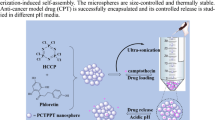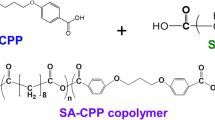Abstract
Microspheres which were sensitive to pH change were developed by utilizing cinnamic acid (CA) as a physical cross-linker for poly(ethyleneimine) (PEI). At pH 7.0, the microspheres were efficiently formed at the PEI/CA ratio of 1:3.4, 1:5.1, and 1:7.1 (w/w), which corresponded to the protonated amino group/deprotonated carboxyl group ratio of 5:5, 4:6, and 3:7. The mean diameter of wet microspheres was 3.2 ± 0.3 to 8.8 ± 0.5 μm and that of dry ones was 1.7 ± 0.2 to 2.7 ± 0.2 μm. The microspheres were disappeared upon the alkalification, possibly because the electrostatic interaction between PEI and CA was slackened down and the hydrophobic interaction among CA molecules was weakened. At pH 5.0 and 7.0, the microsphere released its content in a sustained manner and the release degree in 24 h was less than 40%. Whereas, at pH 8.0 and 9.0, the microsphere exhibited a burst release and the release degree in 24 h was greater than 80%. In the alkali condition, not only the electrostatic interaction between PEI and CA but also the hydrophobic interaction among CA molecules became weaker, leading to the disintegration of the microsphere and resulting in a burst and intensive release.






Similar content being viewed by others
References
Bae, Y. H., Okano, T., Hsu, R., & Kim, S. W. (1987). Thermo-sensitive polymers as on-off switches for drug release. Die Makromolekulare Chemie, Rapid Communications, 8, 481–485.
Chiu, H. C., Hsiue, G. H., Lee, Y. P., & Huang, L. W. (1999). Synthesis and characterization of pH-sensitive dextran hydrogels as a potential colon-specific drug delivery system. Journal of Biomaterials Science, Polymer Edition, 10, 591–608.
Dong, L. C., & Hoffman, A. S. (1991). A novel approach for preparation of pH-sensitive hydrogels for enteric drug delivery. Journal of Controlled Release, 15, 141–152.
Gerasimov, O. V., Boomer, J. A., Qualls, M. M., & Thompson, D. H. (1999). Cytosolic drug delivery using pH-and light-sensitive liposomes. Advanced Drug Delivery Reviews, 38, 317–338.
Javid, A., Ahmadian, S., Saboury, A. A., Kalantar, S. M., Rezaei-Zarchi, S., & Shahzad, S. (2014). Biocompatible APTES–PEG modified magnetite nanoparticles: effective carriers of antineoplastic agents to ovarian cancer. Applied Biochemistry and Biotechnology, 173, 36–54.
Bosio, V. E., Machain, V., López, A. G., De Berti, I. O. P., Marchetti, S. G., Mechetti, M., & Castro, G. R. (2012). Binding and encapsulation of doxorubicin on smart pectin hydrogels for oral delivery. Applied Biochemistry and Biotechnology, 167, 1365–1376.
Du, J. Z., Du, X. J., Mao, C. Q., & Wang, J. (2011). Tailor-made dual pH-sensitive polymer–doxorubicin nanoparticles for efficient anticancer drug delivery. Journal of the American Chemical Society, 133, 17560–17563.
Hörter, D., & Dressman, J. B. (2001). Influence of physicochemical properties on dissolution of drugs in the gastrointestinal tract. Advanced Drug Delivery Reviews, 46, 75–87.
Bowersock, T. L., HogenEsch, H., Suckow, M., Guimond, P., Martin, S., Borie, D., Torregrosa, S., Park, H., & Park, K. (1999). Oral vaccination of animals with antigens encapsulated in alginate microspheres. Vaccine, 17, 1804–1811.
Kumar, A. M., & Rao, K. P. (1998). Preparation and characterization of pH-sensitive proteinoid microspheres for the oral delivery of methotrexate. Biomaterials, 19, 725–732.
Ribeiro, A. J., Silva, C., Ferreira, D., & Veiga, F. (2005). Chitosan-reinforced alginate microspheres obtained through the emulsification/internal gelation technique. European Journal of Pharmaceutical Sciences, 25, 31–40.
Yu, C. Y., Yin, B. C., Zhang, W., Cheng, S. X., Zhang, X. Z., & Zhuo, R. X. (2009). Composite microparticle drug delivery systems based on chitosan, alginate and pectin with improved pH-sensitive drug release property. Colloids and Surfaces B: Biointerfaces, 68, 245–249.
Kang, M. K., & Kim, J. C. (2010). FITC-dextran releases from chitosan microgel coated with poly (N-isopropylacrylamide-co-methacrylic acid). Polymer Testing, 29, 784–792.
Yang, X., & Kim, J. C. (2010). β-Cyclodextrin hydrogels containing naphthaleneacetic acid for pH-sensitive release. Biotechnology and Bioengineering, 106, 295–302.
Semkina, A., Abakumov, M., Grinenko, N., Abakumov, A., Skorikov, A., Mironova, E., Davydova, G., Majouga, A. G., Nukolova, N., Kabanov, A., & Chekhonin, V. (2015). Core–shell–corona doxorubicin-loaded superparamagnetic Fe3O4 nanoparticles for cancer theranostics. Colloids and Surfaces B: Biointerfaces, 136, 1073–1080.
Maas, A. H. J., Rispens, P., Siggaard-Andersen, O., & Zijlstra, W. G. (1984). On the reliability of the Henderson-Hasselbalch equation in routine clinical acid-base chemistry. Annals of Clinical Biochemistry, 21, 26–39.
Zou, Y., Rossi, N. A., Kizhakkedathu, J. N., & Brooks, D. E. (2009). Barrier capacity of hydrophilic polymer brushes to prevent hydrophobic interactions: effect of graft density and hydrophilicity. Macromolecules, 42, 4817–4828.
Acknowledgements
This research was supported by the Basic Science Research Program through the National Research Foundation of Korea (NRF) funded by the Ministry of Education (NRF-2015R1D1A1A01057279).
Author information
Authors and Affiliations
Corresponding author
Rights and permissions
About this article
Cite this article
Park, D., Lee, SJ. & Kim, JC. pH-Sensitive Self-Assembled Microspheres Composed of Poly(Ethyleneimine) and Cinnamic Acid. Appl Biochem Biotechnol 184, 253–263 (2018). https://doi.org/10.1007/s12010-017-2534-0
Received:
Accepted:
Published:
Issue Date:
DOI: https://doi.org/10.1007/s12010-017-2534-0




